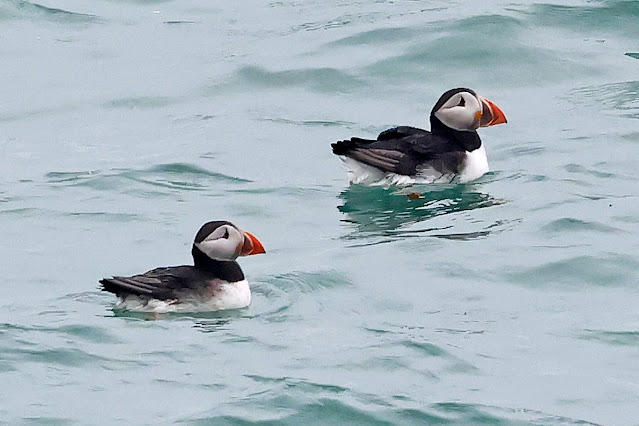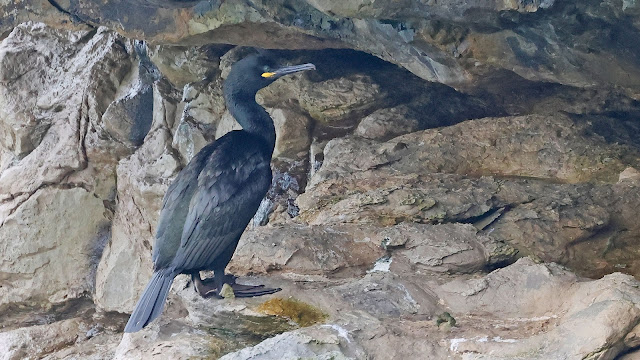Durlston Country Park is a location Ian and I usually visit in early June. At that time there are butterflies and orchids to find and the auks are nesting on the cliff ledges. However this year we were looking for two orchids I have never seen before. The auks are in position but not necessarily breeding yet, so we should also be able to catch up with them.
Friday had been nice and sunny and the hope was it would be the same for the visit to Dorset, but as we headed west the skies were overcast and as we got closer to Swanage we could see mist on the Purbeck hills.
In the car park it was overcast, but there wasn't any real mist. It was though quite cool in the fresh south west wind. Walking down the hill to the Lighthouse a Swallow flew over and a Whitethroat was singing in the bramble. With the conditions dull it was difficult to photograph. We thought we would see many more along the cliff top path, but this was the only one we came across
We were here to find Early Spider Orchids and Green-winged Orchids. We had some idea where to look, apparently field 10 next to the lighthouse. We stood at the gate and scanned the field, nothing stood out, so we walked through the gate and walked up the hill, almost immediately we came across the Early Spider Orchid.
And right next to it the Green-winged Orchid.
These two orchids are the earliest to flower in the United Kingdom, and these had clearly been in flower for a while because some of the Early Spider had been pollinated, the flower head going yellow.
We decided to walk on, the forecast was for the sun to break through later so we thought we would be able to photograph them in better light. Below us on the water was a raft of Guillemots.
As we walked west along the cliff path we had a couple of Gannets offshore and a brief glimpse of a male Peregrine carry prey along the top of the cliff. As expected a few Stonechats along the fence by the path.
Ravens called a used the breeze to glide past above us.
And Roe Deer could be seen on the cliffs.
I thought the path might be muddy and it was in places but it was drier than expected. In the summer there are always butterflies and singing birds to keep you entertained, but today it was a tough slog along the paths.
As we got closer to Dancing Ledge and hopefully a good selection of auks we heard the call of a Peregrine once again. It showed above the cliff and with out flapping a wing it soared above the slopes, away from us and then out to sea before coming back. We lost it for a minute, then it burst out from below the cliff and passed us at eye level.
From the size we assumed this was the male.
Plenty of Jackdaw along the cliff path, many collecting nesting material.
Just before we reached the path to dancing ledge we found the field to be covered once again in Early Spide Orchids.
And Green-winged Orchids. The Green Winged is similar to the Early Purple Orchid, but appears earlier and has unmarked leaves which have dark veins that give it the name. It is most abundant in damp, unimproved pastures on calcareous or neutral soils. They can be found in huge numbers in areas such as village greens and churchyards, these orchids on the chalk grasslands can be a little smaller than those. The lateral sepals form a hood that also has prominent dark veins
Leaving the orchids a Fulmar flew past.
We made our way down to Dancing Ledge, there was quite a few climbers present but we moved away from them and walked to the far west side. The first thing to catch my eye was a pair of Razorbill on a ledge that was visible, on all other trips we have not seen them on cliffs at all.
So much was going on, but we were mainly here to see the Puffins and they were showing very well and for once not a speck on the water, almost below our feet. I will show all the auks in sequence rather than chronologically, so first up, the Puffins.
They were in pairs on the water and we could see six birds.
These are the only Puffins seen in what can be classified as South East England, i probably easier to say these are Puffins furthest east on the south coast. The concern now is that the colony is unsustainable, the nearest other colonies being Alderney and Sark, too far away to support these birds.
They have not successfully bred for a few years now and it is highly unlikely they will in the future, so things do not look good. The National Trust have installed camera to see what happens but even so the chances of these Puffins continuing here is slim.
So it is a case of enjoying these birds for as long as you can and today we were being treated to some great views.
They would either dive or fly off, but would return, here drifting around the side of the cliffs.
Also when they did fly they also came close.
Next the Razorbills, they seemed quite happy on the cliff ledge.
A Razorbill in summer plumage is an extremely smart looking bird.
One of the pair flew down to settle on the water.
And then some interesting behaviour, mating, the male showing the yellow gape as he balanced.
The Guillemots were mostly drifting and bobbing around on the water. Interestingly they seem to organize themselves in lines across the water.
They were also seen in flight heading around the corner and up to the cliffs.
A pair of Shag flew past, one disappearing around the corner while the other settled on the ledge the Razorbill had been using, they had found a way to get into the rocks.
Then flew off and away.
Finally there were several Rock Pipits flying around the cliffs along with the Feral Pigeons. This one settled on a Rock, the red and blue colours are the clothes of the climbers.
The forecast break in the cloud was becoming a distant hope now, in fact sea mist was closing in around us, so it was time to leave and climb back up to the cliff path.
We checked the field at the top of the steps and of course there were many more Early Spider Orchids. They are quite small and unlike the Bee Orchids do not have that many flowers, two being the most we found. It is usually the first orchid to flower, sometimes in late March. They are very common in continental Europe, but here in the UK this is the edge of its range, primarily coastal in Dorset, Kent and East Sussex.
The flowers have a rounded, furry edged brownish lip with a silver blue "H" shaped speculum and lime green sepals. Of the four
Orphys Orchids, Fly is scarce, Early Purple has the stated restricted distribution, and the Late Spider Orchid is one of Britain's rarest Orchids, that leaves the Bee Orchid that because it is self pollinating is the commonest.
This orchid is named after its appearance, with its flowers apparently
resembling the abdomen of orb-weaver spiders. However, its flower shape
has evolved so that it resembles bees, which come to try and mate with the
flower, known as pseudo-copulation.
Here we have one pollinated flower, showing as a yellowish flower.
Leaving the orchids in that field we did find many more as we walked back. We also came across this female Wheatear, I have put a lot of effort into trying to find one this spring, so this was a nice find.
The walk was a slog back as it was going. This Kestrel was using the breeze and lift from the cliff to hunt. Just after this was taken it dropped and appeared with what looked like a vole.
As we approached the Lighthouse the mis was closing in on the cliff tops, below the sea was a little clearer, this Gannet passing quite close.
Back at the car the mist was getting thicker and we could see it blowing past. It was also quite cold. It did not look like this was going to lift, so we decided to call it and head back into Hampshire. The day wasn't over.























































No comments:
Post a Comment